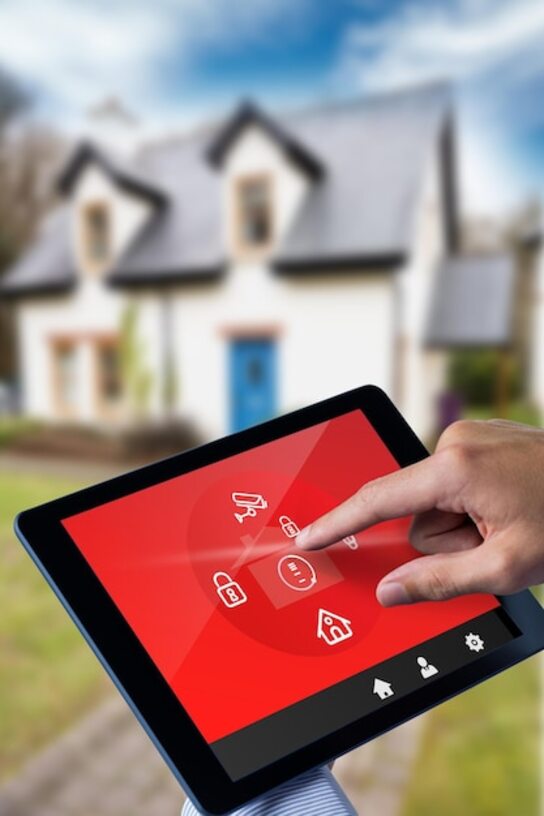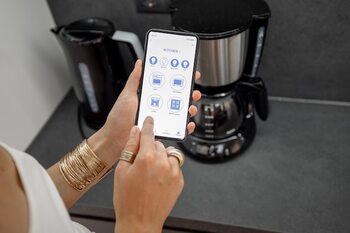Integrated security technology for the home of the future

Home security has evolved impressively, and integrated technology is transforming our spaces into smart fortresses. Imagine being able to monitor your house from anywhere, receive instant alerts, and control devices with a simple touch on your smartphone. In this article, we will explore how future security technology not only protects your home but also enhances your quality of life. Discover the most exciting innovations that are at your fingertips and learn how to implement these solutions to ensure your peace of mind.
1. The evolution of home security: A look at the past
The evolution of home security has come a long way from the rudimentary methods used in the past. In its early days, families relied on basic measures, such as wooden locks and physical barriers to protect themselves from intruders. Surveillance was limited to neighborhood observation, and alarms were audible and manual, with little effectiveness. Over time, the invention of more sophisticated devices and the growing concern for safety led to a significant advancement in the technology used to protect homes. This is how more complex alarm systems and cameras that offered a broader view of the environment began to emerge, although they were still limited by their analog capabilities.
As the decades progressed, digitalization radically transformed the security landscape. The arrival of interconnected systems allowed homeowners not only to monitor their homes from afar but also to receive instant alerts about any suspicious activity. The use of technologies such as motion sensors and IP cameras marked a significant milestone in this evolution. Today, thanks to the rise of the Internet of Things (IoT), it is possible to integrate multiple devices into a single platform that allows centralized control from our smartphones or tablets. This progress has not only increased the effectiveness of home protection but has also enabled people to feel safer and more connected to their immediate environment.
2. Smart devices: The heart of modern security
Smart devices have become the heart of modern security, offering a wide range of solutions that not only protect our homes but also integrate into our daily routines. From surveillance cameras with facial recognition to smart locks that can be controlled from an app, these devices allow for constant monitoring and a quick response to any eventuality. The connectivity between the different elements of the system ensures that every corner of your home is under surveillance, providing peace of mind for both you and your loved ones. Furthermore, many of these devices feature advanced technology to adapt their functioning according to your habits and preferences.
Simplicity in interaction is another key aspect of smart devices. With a touch on your smartphone or through voice commands, you can access complex functions effortlessly. For example, smart lights can automatically turn on when detecting motion or be programmed to simulate your presence at home while you are away. This capability not only enhances security by deterring potential intruders but also optimizes energy consumption and creates a more welcoming environment. With the continuous evolution of artificial intelligence and the Internet of Things (IoT), the possibilities are endless, making home security more accessible and efficient than ever.
3. Surveillance systems: Cameras and sensors that keep you connected
The integration of home surveillance systems has revolutionized the way we protect our spaces. Modern security cameras, equipped with artificial intelligence technology and night vision, not only record images but also analyze behavior in real-time. This means you can receive instant notifications if unusual activity is detected, allowing you to react quickly from anywhere via your smartphone. Additionally, many of these cameras offer two-way audio features, enabling you to communicate with those at home or deter potential intruders.
Sensors also play a crucial role in creating a comprehensive surveillance system. From motion sensors to opening detectors for doors and windows, these devices work together to provide complete coverage. When combined with intuitive mobile applications, homeowners can customize alerts and easily monitor their home. This connectivity not only provides invaluable peace of mind knowing that your home is protected 24/7, but also allows for a quicker response to any eventuality. With these technologies at hand, maintaining security and control over our environment has never been more accessible.
4. Smart alarms: How they work and why they are essential
Smart alarms are one of the most notable innovations in the field of home security. Unlike traditional systems that rely on sirens and manual notifications, smart alarms are designed to offer continuous, real-time monitoring through mobile apps. These alarms can detect movements, temperature changes, or even unusual noises, sending instant alerts to your phone. This means you can stay informed about what happens in your home no matter where you are, providing you with invaluable peace of mind. Additionally, smart alarms often integrate with other security devices such as cameras and door and window sensors. This connectivity allows for the creation of a comprehensive system that not only reacts to intrusions but also acts proactively to prevent incidents. For example, if an unauthorized entry is detected, the system can automatically activate outdoor lights and record video to provide clear evidence. In a world where security is paramount, having these tools is not only convenient; it is essential for protecting your family and your most prized possessions.
5. Home Automation: Security and Comfort in One Step
Home automation is one of the most revolutionary innovations in the field of security and comfort. With the integration of smart devices, such as surveillance cameras, electronic locks, and connected alarms, homeowners can have total control over their environment from anywhere. Imagine being able to check your home’s cameras in real-time through your mobile phone or receive instant notifications if any suspicious movement is detected. This capability not only provides an additional layer of security but also offers peace of mind knowing that you can react quickly to any eventuality.
Additionally, home automation goes beyond simple monitoring; it also optimizes daily comfort. For example, you can schedule your lights to turn on automatically at sunset or adjust the thermostat before arriving home to create a cozy atmosphere. The interconnection between devices allows for personalized routines that adapt to your lifestyle. In this way, you are not only creating a safer space but also one that easily responds to your needs and preferences. The perfect combination of security and comfort makes each day simpler and more enjoyable, turning your home into a smart and efficient refuge.
6. Integration with virtual assistants: Total control at your voice's reach
The integration of virtual assistants into home security systems has revolutionized the way we interact with our devices. With just a voice command, you can activate or deactivate alarms, check security cameras, and receive updates on the status of your home. This convenience not only simplifies the monitoring process but also allows users to manage their security even when their hands are full. Imagine arriving home with shopping bags and, without needing to search for keys or take out your phone, simply asking your virtual assistant to unlock the door and turn on the lights.
Additionally, integration with virtual assistants allows for unprecedented personalization in home management. You can schedule daily routines where all devices synchronize to create a safe and welcoming environment. For example, by saying "Good morning," all the lights will gently turn on while alarms are disabled and cameras are checked to ensure everything is in order. This type of automation not only enhances the physical security of the space but also promotes a smoother and more enjoyable experience for its inhabitants. In a world where more and more tasks are performed through smart technology, the combination of security and voice control is definitely the future of well-being at home.
7. Cybersecurity: Protecting your data and privacy in the smart home
In a smart home, where devices are interconnected and share data in real time, cybersecurity becomes a fundamental priority. Each new gadget that is incorporated into our daily lives, from security cameras to smart thermostats, can be an open door for potential threats. Therefore, it is vital to implement robust protective measures that safeguard both our personal data and the privacy of our daily activities. Using strong passwords, enabling two-factor authentication, and keeping the firmware of devices updated are essential steps to ensure a secure digital environment.
In addition to basic precautions, investing in dedicated cybersecurity solutions can provide an additional layer of defense. There are applications and services that monitor traffic on the home network, detecting unusual behaviors that may indicate intrusion attempts. It is also advisable to segment the home network by creating a separate network for smart devices; this limits access to sensitive information while allowing the benefits of a connected home without compromising security. By prioritizing cybersecurity, we not only protect our digital assets but also ensure a safer and more efficient environment for the whole family.
8. Future trends in home security technology
As technology advances, future trends in home security focus on the integration of smarter and more autonomous systems. Homes of the future will be equipped with interconnected devices that not only provide surveillance but also learn from the behavior of their inhabitants. For example, security cameras with artificial intelligence will be able to differentiate between a family member and a stranger, sending personalized alerts based on facial recognition. Additionally, motion detection systems will be capable of adjusting their sensitivity according to the time of day and the usual activity in each space, thereby minimizing false alarms and enhancing the user experience. Another exciting trend is the use of blockchain-based technologies to ensure the privacy and security of the data collected by these devices. With an increasing focus on cybersecurity, homes will be protected not only against physical intruders but also against potential digital threats. The implementation of mesh networks will allow for smoother communication between all connected devices, ensuring that each component of the system works in harmony to provide robust and efficient protection. As these innovations become more accessible, homeowners will enjoy unprecedented peace of mind knowing that their home is protected by advanced and reliable technologies.
9. Practical tips for implementing a comprehensive security system
To implement a comprehensive security system in your home, it is essential to start with a thorough assessment of your needs and vulnerabilities. Identify critical points, such as main entrances, windows, and dark areas outside. Once you have a clear understanding of where the risks are, you can select appropriate security devices, from surveillance cameras to motion sensors. Make sure to choose technologies that are compatible with each other and can be integrated into a centralized platform for easier management and monitoring.
The installation of these systems must be meticulous; consider hiring professionals if you don't feel confident doing it yourself. Additionally, it is essential to keep your devices updated to protect against potential security breaches. Don't forget to involve all household members in using the system: establish clear protocols on how to respond to alerts or suspicious situations. Ultimately, the key to an effective security system lies in the right combination of advanced technology and the active participation of those who inhabit the home.



